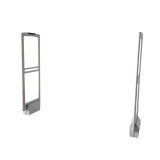Are you looking for a reliable and secure way to protect your business assets? Look no further than the RFID locking system. This innovative technology offers businesses a convenient and efficient way to control access to their premises or sensitive areas. This article will explore the advantages of implementing an RFID locking system in your business and how it can revolutionize security measures.
What is an RFID locking system?
An RFID locking system utilizes radio frequency identification technology to grant or restrict access to a specific area or item. It has three main components: RFID tags, RFID readers, and a centralized control system. The RFID tags, typically cards or key fobs, contain unique identification information that the RFID readers read. The readers communicate with the centralized control system, which then determines whether to grant or deny access based on the authorization level of the RFID tag.
6 Advantages of an RFID locking system for businesses

1. Enhanced security
One of the primary advantages of an RFID locking system is its enhanced security features. Unlike traditional locks that can be easily picked or keys that can be duplicated, RFID locking systems provide higher protection against unauthorized access. The unique identification stored on the RFID tags makes it nearly impossible for intruders to bypass the system without proper authorization. This added layer of security can give business owners peace of mind, knowing that their assets are well-protected.
2. Convenience and ease of use
RFID locking systems offer convenience and ease of use for employees and management. With RFID tags, employees no longer need to carry multiple keys or remember complex access codes. Instead, a simple swipe or proximity to the RFID reader is required to gain entry. This saves time and eliminates the hassle of searching for keys or inputting lengthy codes. Additionally, management can easily control and monitor access permissions remotely, making it simple to add or revoke access for employees as needed.
3. Integration with existing systems
Another advantage of RFID locking systems is their ability to integrate seamlessly with existing security systems and infrastructure. Whether you already have a surveillance system or an access control system, an RFID locking system can be easily incorporated. The centralized control system can be connected to other security devices, such as alarms or video cameras, providing a comprehensive security solution for your business.
4. Audit trail and reporting
RFID locking systems provide a reliable way to track and monitor access to different areas within your business. Every interaction with the RFID reader is logged and recorded, creating an audit trail of who accessed a specific area and when. This can be invaluable in security breaches or incidents, as it quickly identifies potential culprits. Additionally, the reporting capabilities of RFID locking systems enable businesses to analyze access patterns and identify any anomalies or areas that require additional security measures.
5. Remote access control
One of the critical advantages of an RFID locking system is the ability to control and monitor access remotely. A centralized control system allows management to add or remove employee access permissions in real-time easily. This is especially useful when employees may need temporary or restricted access, such as during off-hours or for specific projects. Remote access control also allows for quick response to security threats, enabling immediate revocation of access for lost or stolen RFID tags.
6. Scalability and future-proofing
RFID locking systems offer scalability, making them suitable for businesses of all sizes. Whether you have a small office or a large enterprise, RFID locking systems can be easily expanded as your business grows. You can add more RFID readers and tags without disrupting the existing infrastructure. Additionally, RFID technology continues to evolve, offering businesses a future-proof solution. As new advancements are made, you can upgrade your system to take advantage of the latest features and security enhancements.
Conclusion
In conclusion, implementing an RFID locking system in your business can provide many benefits, including enhanced security, convenience, integration with existing systems, improved accountability and audit trail, flexible access permissions, remote access control, scalability, and future-proofing. By leveraging the power of RFID technology, you can revolutionize your security measures and protect your business assets effectively.
FAQs
1. Where are RFID locks used?
RFID locks are used in various applications to enhance security and streamline access control. Common areas where RFID locks find use include:
- Hotels: RFID locks are prevalent in the hospitality industry, providing keyless entry for guests using RFID key cards or mobile devices.
- Offices: Many office buildings use RFID locks to control access to different areas, ensuring only authorized personnel can enter specific rooms or floors.
- Residential Buildings: Some modern homes and apartment complexes employ RFID locks for secure and convenient entry.
- Healthcare Facilities: RFID locks secure access to sensitive areas within hospitals and clinics, helping maintain patient privacy and protect medical equipment.
- Education Institutions: Schools and universities utilize RFID locks to control access to classrooms, laboratories, and other restricted areas.
- Commercial Spaces: Businesses may deploy RFID locks to secure storage rooms, data centers, or other critical areas.
RFID locks provide a flexible and efficient means of access control, improving security and simplifying management in various environments.
2. What is the principle of an RFID door lock?
The RFID door lock principle involves users presenting RFID tags or cards containing unique identifiers to an RFID reader installed in the lock. The reader emits a radio frequency signal, and upon authentication, the identifier is sent to an access control system. If the identifier is valid and matches an authorized user, the door lock mechanism is activated to unlock the door, allowing access. In cases where the identifier is not recognized or authorized, access is denied. This secure and efficient access control system is widely employed for keyless entry in applications such as hotels, offices, and residential buildings.
3. How safe are RFID locks?
RFID locks are generally secure, contingent on factors like encryption strength, authentication methods, and overall system design. High-quality RFID locks utilize robust encryption to safeguard communication between devices, while effective user authentication methods enhance security. The overall design of the access control system, including secure data management practices, contributes to the safety of RFID locks. Additionally, physical security features, such as tamper-resistant construction, play a role in preventing unauthorized access.
4. Why are RFID door locks essential?
RFID door locks are crucial for their dual role in enhancing security and providing convenience. By employing unique identifiers and authentication methods, these locks ensure controlled access, reducing the risk of unauthorized entry and bolstering overall security. RFID door locks’ keyless and streamlined entry process enhances user convenience and contributes to operational efficiency in diverse environments.


































